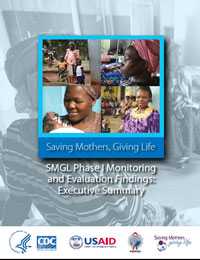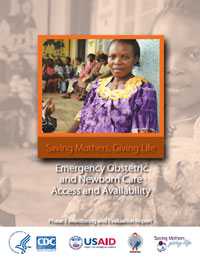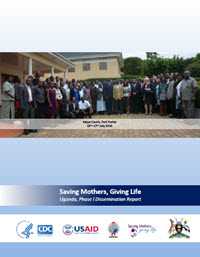Saving Mothers, Giving Life Initiative
SMGL is a public-private partnership to rapidly reduce the number of deaths that are due to complications of pregnancy and childbirth by promoting evidence-based, effective interventions during labor, delivery and immediately after birth. This initiative seeks to augment existing national maternal, neonatal, and child health programs by strengthening the district health system platforms (infrastructure, human resources, commodities, quality of care, accountability for and use of results in program management), improving access, and generating increased demand for health services. SMGL was launched in June 2012 as a pilot project in two countries, with plans to scale up in additional countries with high rates of maternal mortality.
As one of the SMGL partners, CDC’s Division of Reproductive Health (DRH) collaborated on the monitoring and evaluation activities that assessed the effectiveness of the SMGL approach and its components during Phase 1 of the initiative. Specifically, DRH provided technical assistance on designing, planning, and implementing multiple monitoring and evaluation (M&E) approaches, as well as analyzing and interpreting the M&E data. The topic-specific reports below describe how the evaluation activities were carried out, and the SMGL initiative’s effects on
Also available is a report specifically on Uganda’s Phase 1 results and Phase 2 plans.
Reports
- The Executive Summary provides an overview of the SMGL Phase 1 (2012-2013) results: maternal mortality declined in the 8 SMGL-supported districts in Uganda and Zambia through intense efforts to strengthen health services and link communities with health centers for augmenting safe delivery care.  In addition, access to obstetric care increased, health facility infrastructure improved, and emergency obstetric and newborn care coverage increased.
- Download Monitoring and Evaluation Findings: Executive Summary [PDF- 2.73MB]
- The report on Emergency Obstetric and Newborn Care Access and Availability describes the improvements that were made to the health facility infrastructure, to women’s access to obstetric care, and to the quality of that care. These improvements helped to reduce the rate of death among women experiencing obstetric complications. Among the improvements were those in the areas of transportation, water, electricity, communication, referrals, trained delivery care, staffing, supplies of medications, HIV testing, and the number of facilities that provided Basic or Comprehensive Emergency Obstetric and Neonatal Care. The report also discusses how the data on these improvements were collected and analyzed.
- Download Emergency Obstetric and Newborn Care Access and Availability [PDF- 1.3MB]
- The Monitoring and Evaluation Overview describes the theory and the structure of the SMGL monitoring and evaluation processes, which were crucial to determining the effectiveness of the SMGL approach and of its component parts. The report details the SMGL package of interventions aimed to strengthen the district health platform, the principles that guided the monitoring and evaluation (M&E) activities, and the M&E Results Framework and measurement approaches. The report also presents the achievements of SMGL’s M&E approach, the lessons learned, and recommendations for the next phase of SMGL.
- Maternal and Perinatal Outcomes in Health Facilities describes the improvements achieved during SMGL Phase 1 in nearly all commonly used measures of maternal and perinatal health. There were increases in the rates of women delivering in health facilities and in emergency obstetric facilities; more women in labor received advanced treatment for obstetric complications; and maternal and perinatal mortality rates in health facilities declined. The report also discusses how the data on these declines were collected and analyzed.
- Download Maternal and Perinatal Health Outcomes in Health Facilities [PDF- 973KB]
- The Maternal Mortality report details how maternal mortality rates in the 8 pilot districts in Uganda and Zambia declined by one-third in one year. It also examines the declines in direct and indirect obstetric causes of maternal death and how data on cause-specific mortality could inform program actions. For Uganda, the report also discusses the timing of death relative to the birth, where maternal deaths occurred (at home vs. in a health facility), and the delays in seeking, accessing, and receiving care that may have contributed to maternal deaths. The report also discusses how the data on these declines were collected and analyzed.
- Download Maternal Mortality [PDF- 1.66MB
- During July 16-17 2014, national and district stakeholders of the SMGL Initiative in Uganda met to discuss district-specific results and lessons learned during Phase 1, and to plan the priorities and interventions of Phase 2. This report presents the proceedings of that meeting and the key findings.
Download SMGL Uganda Phase 1 Dissemination Report [PDF- 2.73MB]
- Page last reviewed: September 14, 2016
- Page last updated: September 14, 2016
- Content source:


 ShareCompartir
ShareCompartir
![Saving Mothers, Giving Life Intitiative Infographic Download the Saving Mothers, Giving Life Initiative Infographic [PDF - 6KB]](../images/global/smgl-infographic-2015_395px.jpg)





